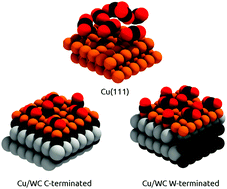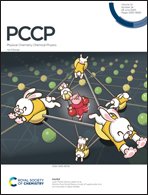Promoting effect of tungsten carbide on the catalytic activity of Cu for CO2 reduction†
Abstract
The adsorption of H, CO2, HCOO, O and CO on copper monolayers and submonolayers supported on hexagonal WC(0001) surfaces has been investigated. Calculations have been performed using density functional theory with the Perdew–Burke–Ernzerhof exchange correlation functional and D2 van der Waals corrections. In addition, dipole corrections were also included. The catalytic properties of supported Cu on both carbon- and metal-terminated WC(0001) surfaces were explored. On carbon-terminated WC(0001) surfaces, Cu tends to be oxidized, while on the metallic terminated surface, it gains charge. The results indicate that all studied Cu/WC(0001) surfaces bind all adsorbates stronger than the extended Cu(111). For CO, the binding energy is so large in some cases (1.6–2.2 eV) that it could potentially lead to catalyst deactivation. Nevertheless, surfaces with an adsorbed Cu monolayer, CuML, are less prone to this deactivation, since there are not WC surface atoms; and thus, the contribution of strong CO adsorption from the support does not play a role. Energy barriers for HCOO formation, relative to direct dissociation barriers of CO2, indicate that a hydrogen-assisted reduction path is more likely to occur on Cu/WC(0001) materials, with CuML/metallic termination being the most active system for this reaction path. On the other hand, CO2 adsorption on CuML surfaces is slightly weaker on a C-terminated surface than on a metal-terminated surface, although both surfaces have similar dissociation barriers. This fact together with the weaker CO adsorption on CuML/C-terminated WC(0001) than on metal-terminated WC(0001) suggests that the former system may be a better catalyst for CO2 reduction, due to the lower surface poisoning by the CO2 dissociation products. Possible deactivation of Cu/WC(0001) materials may be prevented by the introduction of hydrogen into the system, thus promoting the formation of HCOO and avoiding CO and O formation.



 Please wait while we load your content...
Please wait while we load your content...